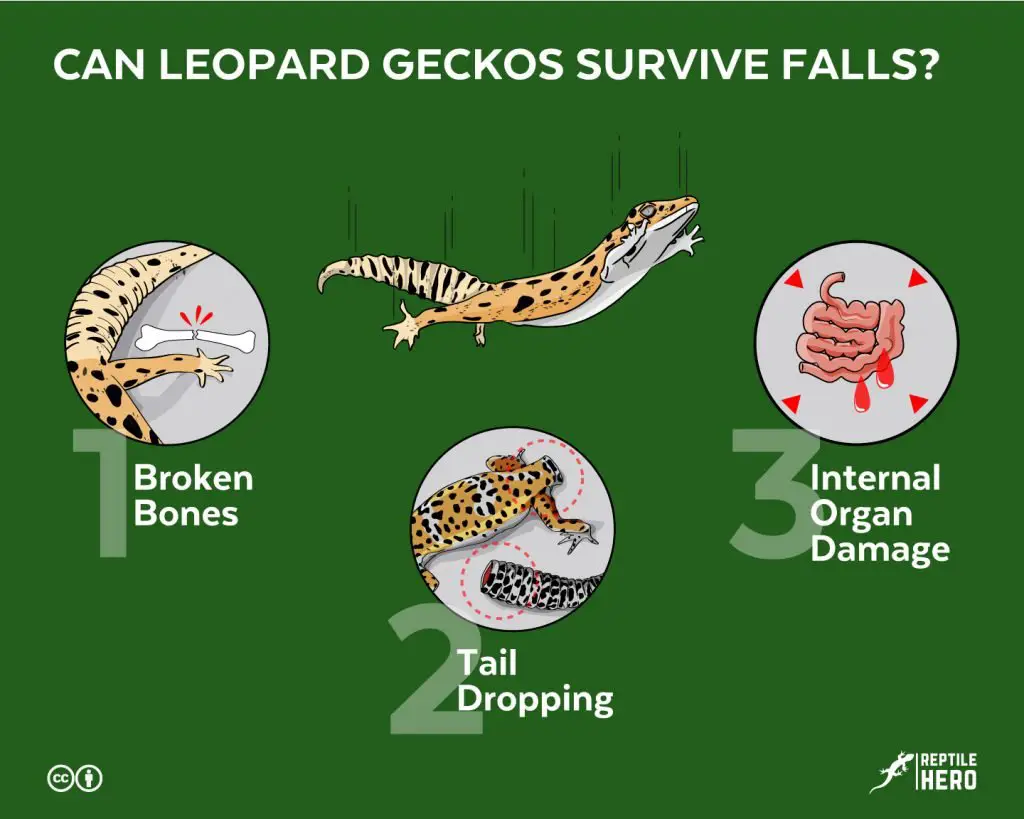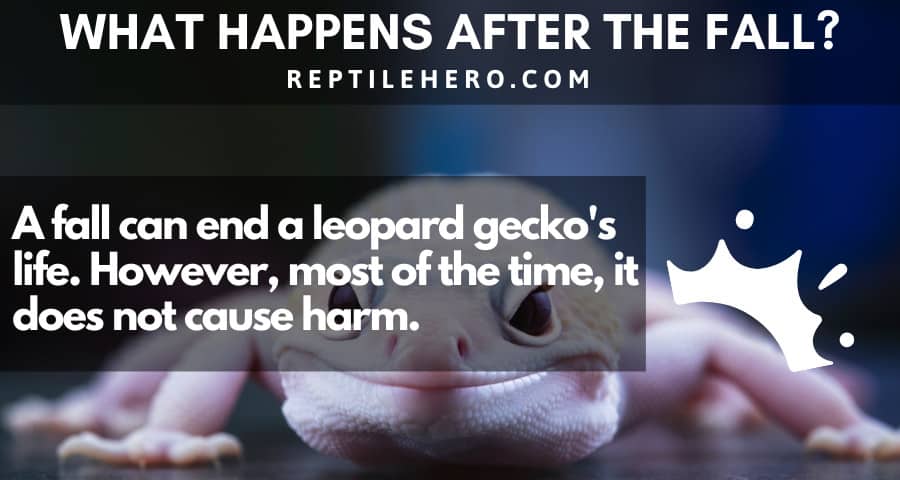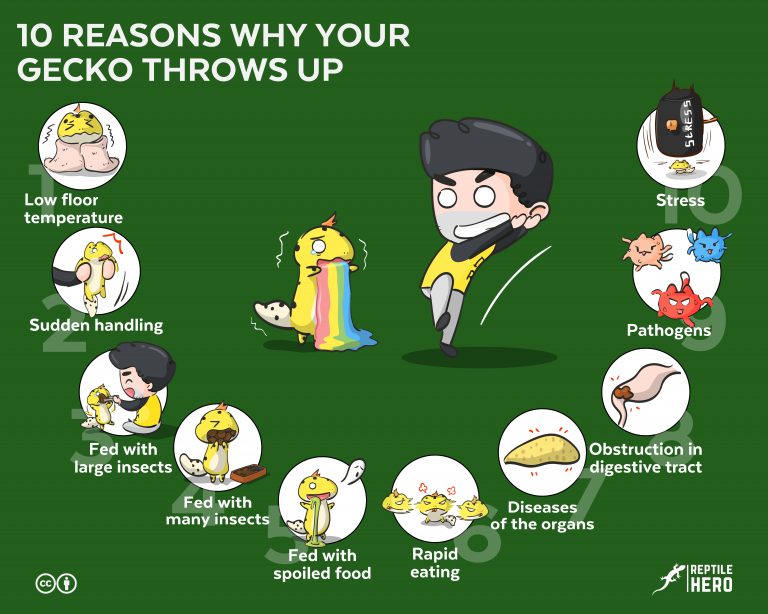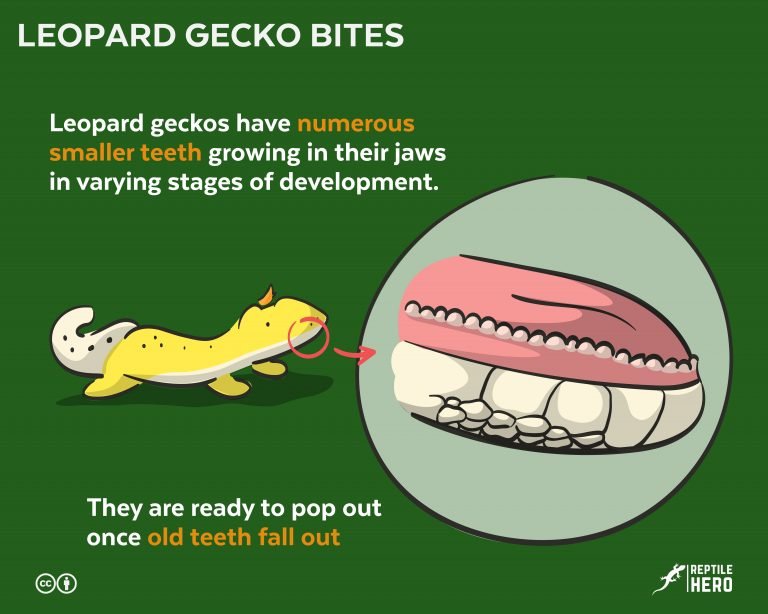Can Leopard Geckos Survive Falls? [2 Real Stories]
Whether or not you are an expert leopard gecko owner, one of the scariest things that could ever happen as a reptile parent is for your beloved pet to fall! It could happen whenever or wherever so long as your gecko decides to jump. Do you think your leo would survive it?
Generally, leopard geckos will survive falls with varying forces of impact. However, although falling will not always kill a gecko, it can leave the gecko seriously ill. Factors such as 1) greater heights, 2) rough and hard surfaces, and 3) poor overall health can worsen the outcome.
If you want to know if other factors can affect the chance of its survival from a fall, keep on reading.
Leopard Gecko Falls! 2 Stories With Different Endings
Typically, you will see several gecko owners on forums panicking because their geckos jumped and fell for whatever reason. Not only do they feel the awful shock but also the adrenaline rush to know if their pet will be fine after falling.
What are the chances that geckos would be injured after falling?
After watching their geckos fall, many owners have observed their leopard geckos unscathed. However, others are left with wounded and hurt geckos following the fall.
Over time, I have met many people who have witnessed their dear leopard geckos falling. In this article, I have compiled the stories of two owners who shared the same unfortunate occurrences. However, each of them had a different ending.
Story #1: A Harmless Fall
There are times when we have to lift our leopard geckos off the surface. For instance, you could be cleaning its tank or rearranging its decorations—like woods and plants—and you need to transfer your gecko to another container. One of my friends has shared how nerve-wracking this can be.
“Keeping my leo’s enclosure clean is always my top priority. One weekend, when I was doing the maintenance, I nearly had a heart attack moment when my gecko slipped from my gentle grasp.
I was midway between the tank and its temporary container when it tumbled onto the floor from my hands. The distance between the floor and my hands was approximately 5 feet. Fortunately, the surface it landed on was covered with a thick carpet.
You may not know, but my leo is not the kind that usually makes jumping part of its ordinary action. So, seeing it jump from my hands with my own eyes is something I was not expecting.
As a result, I now get extra cautious of what I hold my lizard over. Even from as low as 2 feet, I tend to be more conscious than ever! The thought of it jumping again from such a height makes me a tad bit worried. Luckily, nothing serious happened afterward. I guess it landed perfectly fine!”
Many owners may have a similar experience with my friend. Everything is back to normal after the incident. However, some other owners underwent a different outcome.

Story #2: An Unexpected Fall
Proper handling is an excellent way to spend quality time with our reptiles. Frequently, this action does not bring about any harm or surprises. However, according to one of the gecko owners I talked to, this supposedly happy and chill moment ended unexpectedly.
“It was a fine day, and I decided to spend the afternoon with my gecko. I was holding my favorite leo, hugging it quite tightly. However, after a couple of seconds, it suddenly escaped my grasp for the tiled floor that was roughly 2 feet away. The surface it made contact with was cold and definitely hard.
Terror filled my expression as it hit the floor, stomach-side down. What is worse is that the strong crash triggered a tail-drop. As I was about to pick it up, it began running and escaping from me. After a few attempts, I finally caught it and decided to put it back in the tank until the end of the day.
However, the following day came. My dear gecko passed away—cold and silent. While preparing to bury it, I noticed blood pooling in its belly. A bit of it had even trickled out of its mouth. I felt irresponsible for allowing this tragedy to happen.
That was undoubtedly one of the worst days of my life.”

Are Leopard Geckos Designed for Falls?
Generally, leopard geckos are hardy creatures. However, this does not mean that they are anatomically built for falls. Whatever the distance to the surface, they do not always survive the drop or remain unharmed.
Just like any object that plunges from a certain height, a falling leopard gecko applies simple physics in most drops.
This means that there is only a threshold amount of impact needed for skeletal systems and internal organs to break and rupture. Basically, there would be a stronger force when the point of origin gets farther to the surface it would land on. Hence, there is a higher chance of injury when geckos fall from greater heights.
What Does the Anatomy Say?
While the rule of physics applies to a falling leopard gecko, its anatomy may also dictate how its body would take the fall. The two body parts that can usually affect whether the gecko is unharmed or not are the limbs and the tail.
1. Limbs
The limbs of a healthy leopard gecko are short, with clawed toes at the tips. The four limbs should allow them to be agile on flat surfaces. However, these are not built to absorb some of the impacts from a plunge’s direct hit.
Hence, even though a falling gecko that lands on all its limbs may seem to land safely and secure its internal organs, limb bones, and joints could be impaired.
2. Tail
Physiologically, a healthy leopard gecko deposits significant fat stores in its tail base. It does not only serve as an emergency source of energy when fasting. This also helps in protecting internal organs whenever an accident, such as falling, takes place. Thus, it may prevent serious injuries from short falls by reducing the impact.
Even if one would argue that leopard geckos could take light drops because of their tails, they must consider that the geckos still lack other anatomical features to survive drastic falls—especially from very high places.
While they may not be well-adept for jumping (and subsequently falling), they can still jump safely between two points.
3 Other Factors That Affect the Outcome
Although the limbs and tail of leopard geckos can affect how they receive the impact of the fall, three other factors can aggravate the direct hit:
1. Height of the fall. Common sense tells us that falling from a higher origin would inflict more significant damage to the leopard gecko. Thus, there is a higher chance of injuring your gecko when it falls from 6 feet than from 2 feet.
2. Surface of landing. Another thing that common sense would tell us is that landing on rugged and rough surfaces are more likely to cause traumas and injuries to your leopard gecko than on soft and smooth ones.
3. Overall health. The thought of the leopard geckos’ overall health may not strike everyone’s thinking. However, it does influence the damage from the drop. So, a gecko with underlying health problems may not take the fall lightly and can get seriously ill. Conversely, a healthy gecko can better tolerate the impact.
What to Do After the Fall?
After the fall, one must immediately check for any visible injuries on the leopard gecko and take these three necessary steps thereafter:
- Observe the gecko
- Treat the injured part
- Keep the tank clean
The bodies of leopard geckos are not built to take a significant fall. A gecko may take a fall from a couple of feet above the ground and be fine. On another end, another may fall from the same height and die after a couple of hours. Either way, you can follow these three steps after the fall.
Step 1. Observe the Gecko
While time seems to stand still because of how fast the plummet has happened, you may be left in a state of awful shock and your nervous gecko in utter terror. Unfortunately, your reptile only needs one drop or jump for things to go wrong.
Before you worry and rush to the veterinary clinic, look for these signs to determine if your pet is seriously hurt after the awful fall:
- Bruising and traumas
- Loss of appetite and weight
- Odd stance, walking, and movement
- Any other signs of being unwell
With any of those absent after inspection, your gecko may have safely landed the drop. Hence, you have nothing to worry about. So, it pays to keep an eye on the gecko for a few days after the fall. Even if all seems well at the time, developing issues may arise over time.
More commonly, shallow cuts and injuries are the less severe results of a fall. So, you have to treat the injury accordingly. In the event that you suspect broken bones and other more severe signs, promptly bring your gecko to a veterinarian for treatment.
Step 2. Treat the Injured Part
Cuts and injuries will likely not occur if the leopard gecko did not fall on a rough surface like asphalt, cement, or concrete.
However, if you happen to drop your gecko on one of these surfaces, or they did end up with a scrape from another type of hard surface, you will need to start treating it appropriately as soon as possible to prevent it from getting worse.
Step 3. Keep the Tank Clean
A leopard gecko’s enclosure should be clean at any given time. However, if you are dealing with a cut or a scrape, it might be necessary to thoroughly clean out the tank before putting your pet back in it to prevent any further issues.
Infections can transpire if an open wound is exposed to bacteria present in a gecko’s unkempt tank. You have to bear this in mind so that you do not accidentally end up worsening the healing process that may not only stress you and your gecko.

Falling in Other Geckos?
Unlike leopard geckos, other gecko species are known to be nature’s champion climbers. They can scurry across ceilings and up smooth vertical surfaces with exceptional ease, and they do so for a brief period. They can also stop themselves from falling and land most of the time safely.
What are the secrets behind these incredible skills? Are they anatomically built to take great falls?
In research conducted by a group of scientists at the University of California (Berkeley), flat-tailed house geckos (Cosymbotus platyurus) were observed [1]. The team found out that the geckos utilized their tail to maneuver their whole body while falling. In essence, despite plummeting upside-down, they would end up landing stomach-side down.
Perhaps, other geckos with gluey feet—like crested geckos—have also adapted the exact mechanism. Wondered how a crestie jumps from one point to another without falling? Definitely, you would witness their sticky feet at work!
Takeaways
Leopard geckos have no fear of heights, making them prone to danger whenever they instinctively jump from high places, as observed from many stories shared by owners.
Despite jumping and falling, leopard geckos only have their frail limbs and tail to absorb the shock. They are not anatomically equipped to take the impact from high falls.
A responsible owner should prevent geckos from falling as much as possible. If it does happen, immediately look for apparent signs of injuries. If severe damage has been incurred, take the reptile to the veterinarian as soon as possible.
Sources
[1] https://www.livescience.com/4865-falling-geckos-tails-land-feet.html

![How To Properly Handle Your Geckos [6 Facts and 4 Tactics]](https://www.reptilehero.com/wp-content/uploads/2021/12/handle-your-gecko-cc-768x614.jpg)
![Are Christmas Trees Dangerous to Reptiles? [10 Risks & 21 Trees]](https://www.reptilehero.com/wp-content/uploads/2022/01/christmas-tree-pose-risk-reptile-cc-768x614.jpg)
![Why Does Your Gecko Feel So Cold? [6 Potential Problems]](https://www.reptilehero.com/wp-content/uploads/2021/02/G43-768x614.jpg)



